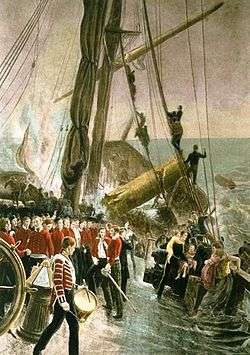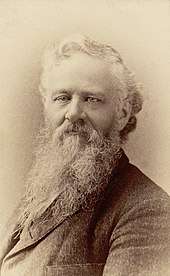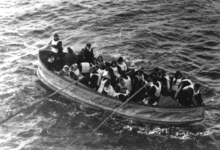Women and children first
"Women and children first" (or to a lesser extent, the Birkenhead Drill)[1][2] is a code of conduct dating from 1852, whereby the lives of women and children were to be saved first in a life-threatening situation, typically abandoning ship, when survival resources such as lifeboats were limited. However, it has no basis in maritime law.

While the phrase first appeared in the 1860 novel Harrington: A Story of True Love, by William Douglas O'Connor,[3][4] the first documented application of "women and children first" was in May 1840 when, after a lightning-strike, fire broke out aboard the American packet Poland en route from New York to Le Havre. According to a passenger, J.H. Buckingham of Boston:
... the captain said that he had little doubt that the ship was on fire, and that we must endeavor to get at it. On a suggestion that we might be obliged to take to the boats, it was immediately remarked by one of our French passengers, and responded to by others – "Let us take care of the women and children first."[5]
This led to a precautionary evacuation of women, children and a few male passengers into the longboat, while the other male passengers and crew remained aboard to fight the blaze.[6] As Buckingham was a journalist, his vivid account of the incident was published first in the Boston Courier, picked up by other papers including The Times (London) and also reprinted in a book published in the same year,[5] thus gaining wide currency.
A more noted instance occurred during the 1852 evacuation of the Royal Navy troopship HMS Birkenhead.[7] It is, however, most famously associated with the sinking of RMS Titanic in 1912.
According to disaster evacuation expert Ed Galea, in modern-day evacuations people will usually "help the most vulnerable to leave the scene first, likely to be the injured, elderly and young children."[7]
In the Boy Scouts of America's Sea Scouting program, "Women and children first" is considered "the motto of the sea".[8]
History
19th century

A well-known appearance of the phrase "women and children first" occurred in the 1860 novel Harrington: A Story of True Love, during the recounting of the death of Captain Harrington, the father of the eponymous character John Harrington. Captain Harrington’s fictional death illustrates not only the concept of "women and children first" but also that of "the captain goes down with his ship".
"Back from the boats," [Captain Harrington] shouts, catchin' up the hand-spike. "The first man that touches a boat I'll brain. Women and children first, men."...
"Timbs," says he, "give my love to my wife and boy, if I never see 'em again. God bless ye, men."...
[Captain Eldad] paused, wiping away with his sleeve the salt tears which the simple epic of a brave man's death brought to his eyes. "That was the story, and them was the last words Timbs brought home to your mother ... An' that's the way he died. Women and children saved. That's a comfort...But he died...
"It was a manly way to leave the world," [John Harrington] said. "Life is sweet to me with the memory of such a father."
— William Douglas O'Connor, Harrington: A Story of True Love (1860)
During the nineteenth and early twentieth centuries, ships typically did not carry enough lifeboats to save all the passengers and crew in the event of disaster. In 1870, answering a question at the House of Commons of the United Kingdom about the sinking of the paddle steamer Normandy, George Shaw-Lefevre said that,[9]
In the opinion of the Board of Trade, it will not be possible to compel the passenger steamers running between England and France to have boats sufficient for the very numerous passengers they often carry. They would encumber the decks, and rather add to the danger than detract from it.
The practice of women and children first arose from the actions of soldiers during the sinking of the Royal Navy troopship HMS Birkenhead in 1852 after it struck rocks.[7] Captain Robert Salmond RN ordered Colonel Seton to send men to the chain pumps; sixty were directed to this task, sixty more were assigned to the tackles of the lifeboats, and the rest were assembled on the poop deck in order to raise the forward part of the ship.[10] The women and children were placed in the ship's cutter, which lay alongside.[11] The sinking was memorialized in newspapers and paintings of the time, and in poems such as Rudyard Kipling's 1893 "Soldier an' Sailor Too".
20th century
By the turn of the 20th century, larger ships meant more people could travel, but regulations were generally still insufficient to provide for all passengers: for example British legislation concerning the number of lifeboats was based on the tonnage of a vessel and only encompassed vessels of "10,000 gross tons and over". The result was that a sinking usually involved a moral dilemma for passengers and crew as to whose lives should be saved with the limited available lifeboats.

The phrase was popularised by its usage on the RMS Titanic.[12] The Second Officer suggested to Captain Smith, "Hadn't we better get the women and children into the boats, sir?", to which the captain responded: "put the women and children in and lower away".[13] The First and Second officers (William McMaster Murdoch and Charles Lightoller) interpreted the evacuation order differently; Murdoch took it to mean women and children first, while Lightoller took it to mean women and children only. Second Officer Lightoller lowered lifeboats with empty seats if there were no women and children waiting to board, while First Officer Murdoch allowed a limited number of men to board if all the nearby women and children had embarked.[14] As a consequence, 74% of the women and 52% of the children on board were saved, but only 20% of the men.[15] Some officers on the Titanic misinterpreted the order from Captain Smith, and tried to prevent men from boarding the lifeboats.[16][17] It was intended that women and children would board first, with any remaining free spaces for men. Because not all women and children were saved on the Titanic, the few men who survived, like White Star official J. Bruce Ismay, were initially branded as cowards.[18]
21st century
There is no legal basis for the protocol of women and children first in international maritime law.
A more recent application of "women and children first" occurred in March 2011, when a floating restaurant in Covington, Kentucky, tore from its moorings, stranding 83 people on the Ohio River. Women were rescued first, but there were no casualties.[19]
See also
- Ida Straus – a passenger aboard the Titanic
- Male expendability
- SS Arctic disaster, a contrary case
Footnotes
- Rudyard Kipling (2005). Collected Verse of Rudyard Kipling. Kessinger. p. 305. ISBN 1-4179-0750-9.
- Heinlein 1978, p. 169.
- "Women and Children First". The Phrase Finder. Retrieved 16 April 2010.
- O’Connor (1860), pp. 187-188
- Howland, Southworth Allen (1840). Steamboat Disasters and Railroad Accidents in the United States (2nd ed.). Worcester. pp. 306.
- The Times (London) 27 June 1840, p. 6; reprinting a report dated 29 May 1840, first appearing in the Boston Courier.
- Castella 2012.
- "Amid 'One Oath, One Law' changes, the Sea Scout promise is here to stay - Bryan on Scouting". Bryan on Scouting. 27 January 2014. Retrieved 15 October 2018.
- The Parliamentary debates (Authorized edition), Volume 200, 21 March 1870, pp. 323–324 H. M. Stationery Office, 1870
- Kingston, William Henry Giles (1899). Our Soldiers: Gallant Deeds of the British Army during Victoria's Reign. London: Nick Hodson.
- "The Wreck of HM Steamer "Birkenhead" – 26 Feb 1852". Capeinfo. Retrieved 12 May 2013.
- Marshall 1912, p. 80.
- Lord 2005, p. 37.
- Barczewski 2006, p. 21.
- Anesi, Chuck. "Titanic Casualty Figures".
- Lord 1997, p. 63.
- Ballard 1987, p. 87.
- Benedict & Gardner 2000, p. 204.
- "Cris Collinsworth among 83 rescued". ESPN. Associated Press. 13 March 2011. Retrieved 29 September 2013.
References
- Ballard, Robert D. (1987). The Discovery of the Titanic. Toronto: Madison. ISBN 978-0-446-67174-3.
- Benedict, Michael Les; Gardner, Ray (2000). "When That Great Ship Went Down". In the Face of Disaster: True Stories of Canadian Heroes From the Archives of Maclean's. New York, N.Y: Viking. ISBN 0-670-88883-4.
- Delap, Lucy (20 January 2012). "Shipwrecked: women and children first?". University of Cambridge.
- de Castella, Tom (16 January 2012). "Costa Concordia: The Rules of Evacuating a Ship". BBC News.
- Elinder, Mikael; Erixson, Oscar (2012), Every man for himself: Gender, Norms and Survival in Maritime Disasters (PDF), Uppsala Universitet, archived from the original (PDF) on 17 April 2012
- George, Alison (30 July 2012). "Sinking the Titanic 'women and children first' myth". NewScientist. Retrieved 31 July 2012.
- Heinlein, Robert Anson (1978). Double Star. Gregg Press. p. 169. ISBN 0-8398-2446-7.
- Lord, Walter (1997). A Night to Remember. New York, NY: Bantam. ISBN 978-0-553-27827-9.
- Marshall, Logan (1912). Sinking of the Titanic and Great Sea Disasters. John C. Winston Company. p. 80. Retrieved 27 February 2008.
- Meagher, Sharon M. (2004). Women and Children First: Feminism, Rhetoric, and Public Policy. Suny Press. ISBN 978-0-7914-8285-8.
- Smiles, Samuel (1859). Self-Help. ISBN 1-4068-2123-3.
- Smith, Wes (29 December 1996). "Sensitive Guys Are Looking More Closely At Their Maleness". Chicago Tribune. Archived from the original on 15 May 2013.
- Stilgoe, John R. (2003). Lifeboat. University of Virginia Press. ISBN 0-8139-2221-6.